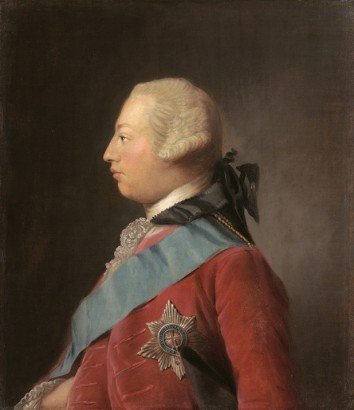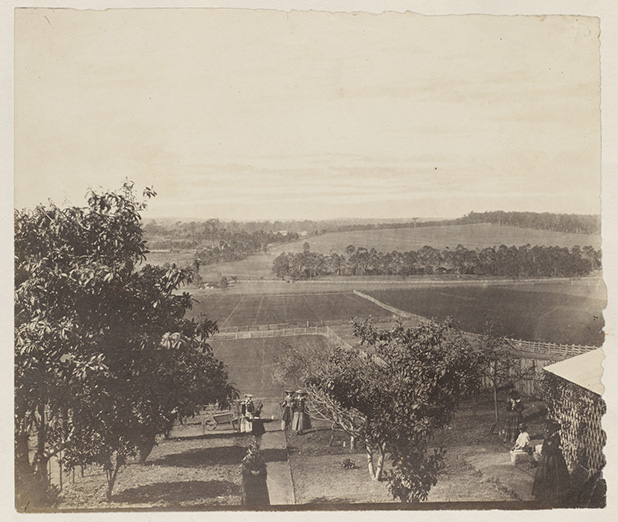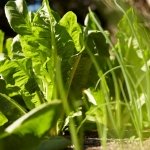The history of Rouse Hill House and Farm is recorded in many ways: in text, in photographs, in the landscape, structures and their contents – and in the archaeological remains that dot the site. These humble glass fragments evoke the site’s earliest European occupancy.
Unearthed during conservation work at the potting shed, located in the south east corner of the garden, was a clutch of shattered green glass. Reassembled, they formed the curved dome-top of a bottle embossed with the initials GR and a broad arrow.

Embossed seal from a glass bottle found at Rouse Hill House and Farm. Photo Scott Hill © Sydney Living Museums

Portrait of King George III by Allan Ramsay, 1762. Wikimedia Commons
The initials are for the Latin Georgius Rex – and stand for King George III, who ruled 1760-1820 and during whose reign the colony of New South Wales was founded. The GR monogram was also used during the reign of His son George IV, who ruled as Prince Regent from 1811- 20, and then in his own right from 1820 – 1830. The central ‘broad arrow’, so familiar to anyone who has seen pictures of convicts with clothing emblazoned with the mark, indicates simply that the bottle was the property of the Board of Ordnance. Being found in possession of marked objects without good cause was a serious offence.
The symbol has been documented back to the 16th century to mark Royal property, and was occasionally referred to as a ‘Royal cipher’. An 1806 proclamation stated that:
The Board having been pleased to direct that in future all descriptions of Ordnance Stores should be marked with the broad arrow as soon as they shall have been received as fit for His Majesty’s Service; all Storekeepers and Deputy Storekeepers and others are desired to cause this order to be accordingly attended to, in the Department under their direction, reporting to the Board in all cases when articles are received to which this mark cannot be applied. [28th July 1806. Quoted from the Royal Australian Army Ordnance Corps website]
As a result the broad-arrow mark appears on everything from furniture to cooking pots and cutlery, packing crates and barrels, construction materials from timber to bricks and tools – and some convict clothing. Its important to remember that it doesn’t necessarily mean an association with convicts.
The Rouse Hill potting shed
Standing at the South east corner of the garden, the potting shed itself dates to the 1850s, at a time when 2nd generation Edwin and his wife Hannah Rouse were making improvements across the property. Recent research has shown that the bulk of the surviving outbuildings at the property actually date from around this period. The eastern section of the garden was a sizable extension to the original gridded plan that extended to the front of the house, as did the contemporary gardens at the Government Houses at Sydney and Parramatta. This early view, taken before the summer house and potting shed were built, shows family members tending fruit trees in the area, which had been used as an orchard. The building to the right is the new bath-house:
In this view you can see the potting shed today. The tall bamboo-like plant behind it is actually Arundo donax, the ‘giant reed’, a native plant from S-East Asia right through to the Mediterranean, and which grew in many colonial gardens.

The potting shed at Rouse Hill House and Farm with view to south-east over the Regional Park. Photo © James Horan for Sydney Living Museums RHF13_0147
Prior to conservation work undertaken in 2008 an excavation was conducted to reveal information about how the paths connecting the shed to the main garden walks and drainage originally worked, and the nature of the earth floors. Archaeological remains discovered ranged from building fragments and ironwork to sherds of terracotta pots, pipes, broken blue-and-white dinnerware – and fragments of a glass bottle.
Compared to intact examples, the width of the reconstructed top indicates the bottle probably stood up to 25cms high, with the sides tapering inwards slightly towards the base. The circular lip was also found, but not the short neck. In volume it would have held a standard half gallon measure. So what did the bottle originally hold? We may never know, as the lower part of the bottle that may have had other marks or even an embossed label is missing. Bottles such as these held everything from lime juice syrup taken on voyages (they are even generically referred to as ‘lime juice bottles’) to prevent scurvy, to medicinal draughts.
What it does represent though is the earliest stage of European occupation at Rouse Hill. Rouse Hill House was built because of “that enthusiastic builder” Governor Macquarie’s new turnpike road, built to replace the earlier road that ran between Parramatta and Windsor. Richard Rouse (1774-1852, seen below in a miniature from the collection), then Superintendent of Public Works at Parramatta, won the contract to build the toll-house, and was also granted land adjacent to it:
THE New Road leading from Parramatta to Windsor, being some time since compleated and two Toll Gates erected thereon, with suitable Houses for the Accommodation of the Gate-Keepers, the Public are informed, that one of those Toll Gates is placed near to the Bridge over the River at Parramatta, and the other at Rouse Hill (some-times called Vinegar Hill), at a Distance of about eight Miles from Windsor; and Tolls will commence to be levied at those Gates, on the 1st Day of January next.
The Sydney Gazette, 27 November 1813
Promised in 1813, Rouse’s grant of 450 acres was made official 3 years later. The house was begun sometime after this, and it was completed around 1819 – and certainly by 1824 when the family relocated from Parramatta. But how did the bottle come to be here? It may have been carried up the hill – and then dropped – by convict laborers working on the turnpike or on Rouse’s property. Perhaps it was discarded from the main house as rubbish when it was an area of orchard that would later be landscaped. Or perhaps it’s even earlier, dating from the time of Governor Hunter’s original Windsor Rd. Its unlikely we’ll ever know – but its fascinating to imagine.
Dig deeper
Did you know the broad arrow mark is still used by the Australian Army Ordnance Corps to mark Department of Defence property? You can read more about the mark at their website.
Read about the British Board of Ordnance here





